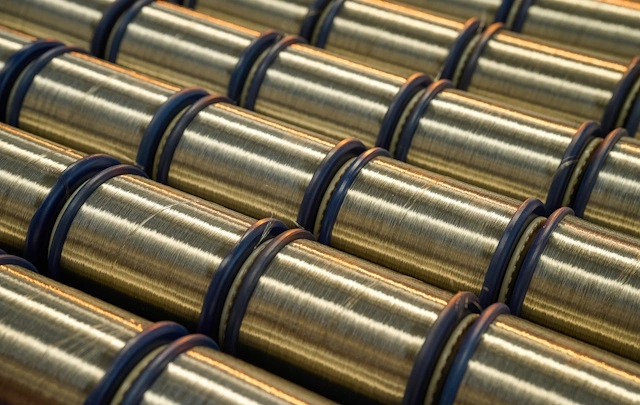What is Braiding Wires?
Braiding wires are the process of transferring multi wires, which are wound and arranged in a specific manner, onto spools.
This process is crucial in industrial applications where fine wires like multi wires are used, as it ensures the smooth transportation, storage, and processing of the products. During this process, the wires are wound with specific tension and arrangement to prevent them from tangling or getting damaged. Oxygen-free copper wires are typically transferred onto spools using high-tech fully automatic machines, with a single wire diameter range of 0.05 mm to 0.320 mm.
As Mega Metal, we transfer our silver-plated, tin-plated, and bare copper wires to Spirka and Wardwell spools in the Braiding wires processes. This way, the wires can be safely used in various sectors such as automotive, industrial applications, and multimedia solutions. In response to the question of how the braiding wires is done, we can say that during this process, the wires are wound onto spools at a controlled speed and environment. Wires transferred onto spools increase efficiency on the production line and provide significant convenience for large-scale projects.

What Are the Reasons for Transferring Multi Wires onto Spools?
The transfer of multi wires onto spools is done to maintain the sensitivity of the wires during the production process and to optimize their performance during use. During the production of multi wires, wires are typically wound onto large spools such as DIN400, DIN630, or DIN560. However, these spools are suitable for the large machines used during the production phase. When the products are used in braiding machines, they need to be transferred to smaller spools weighing 900 gr to 3000 gr. The multi wires conductors transferred onto spools are used for braiding processes at high speeds on braiding machines.
In high-speed rotating machines, centrifugal force (G force) is generated, making it difficult and potentially hazardous to rotate larger spools at this speed. Therefore, it is essential to transfer multi wires onto smaller spools. Wires that have been transferred to spools can be used safely at high speeds on braiding machines, allowing the production process to proceed safely and efficiently. Thus, the transfer of multi wires onto spools is important not only for production efficiency but also for safety.
How is the Process of Transferring Multi Wires onto Spools Carried Out?
The process of transferring multi wires onto spools is carried out precisely using advanced automatic machines. In this process, wires are wound onto DIN400, DIN630, or DIN560 spools during production. However, since these spools are large, they need to be transferred to smaller spools weighing 900 gr to 3000 gr in the bobbin section. This transfer process is carefully executed to ensure that the wires are wound correctly and that no confusion or disorder occurs during production.
During the spool transfer process, the spools are wound properly under appropriate tension, ensuring that the wire's conductivity and flexibility characteristics are preserved. Especially, multi wires conductors can be safely used on high-speed rotating machines after being transferred onto spools. The proper winding of the wires onto the spools ensures a smooth production process and allows high-quality products to be delivered to the end user. At Mega Metal, we meticulously manage this process to ensure that our multi wires transferred onto spools meet quality standards at every stage.
What Are the Application Areas of Transferred Products?
Wires transferred onto spools have a wide range of applications. They are particularly critical for the automotive sector, industrial applications, and multimedia solutions. Transferred multi wires are widely used in essential areas such as precision electronic circuits, energy transmission, and wiring in automotive applications. Transferring these products onto spools facilitates assembly and enables the wires to perform at a high level.
The braiding wires process offers significant time and cost advantages, especially in large projects. Properly wound wires on spools can be used quickly and efficiently without any disruptions during assembly. Moreover, the wires transferred onto spool spools can be used safely at high speeds on braiding machines. This accelerates production processes and allows them to take place in a safe environment.
